Schausiana is a monotypic moth genus of the family Hepialidae described by Pierre Viette in 1950. The only described species is Schausiana trojesa, described by William Schaus in 1901, which is endemic to Mexico.
Cibyra brunnea is a species of moth of the family Hepialidae. It was described by William Schaus in 1901 and is known from Venezuela and Peru.
Cibyra dorita is a species of moth of the family Hepialidae. It was described by William Schaus in 1901 and is known from Brazil.
Cibyra ferruginosa is a species of moth of the family Hepialidae. It was described by Francis Walker in 1856 and is known to live in the northeastern region of Brazil.
Cibyra poltrona is a species of moth of the family Hepialidae. It was described by William Schaus in 1901 and is known from Brazil.
Cibyra tesselloides is a species of moth of the family Hepialidae. It was described by William Schaus in 1901 and is known from Brazil and Paraguay.
Palpifer taprobanus is a moth of the family Hepialidae. It was described by Frederic Moore in 1887 and is found in Sri Lanka.

Sthenopis purpurascens, the four-spotted ghost moth, is a species of moth of the family Hepialidae. It was described by Packard in 1863. It is found in Canada and the United States, from Labrador and New York north and west to British Columbia and the Northwest Territories, south in the mountains to Arizona.

Lophocampa andensis is a moth in the family Erebidae. It was described by Schaus in 1896. It is found in Colombia.
Langsdorfia coresa is a moth in the family Cossidae. It was described by William Schaus in 1901 and is found in Colombia.
Givira durangona is a moth in the family Cossidae described by William Schaus in 1901. It is found in Mexico (Durango) and the United States, where it has been recorded from Colorado.
Givira watsoni is a moth in the family Cossidae. It was described by William Schaus in 1901 and is found in Brazil.
Givira pardana is a moth in the family Cossidae. It is found in São Paulo, Brazil.
Givira plagiata is a moth in the family Cossidae. It was described by William Schaus in 1901 and is found in Venezuela.
Givira sabulosa is a moth in the family Cossidae. It was described by William Schaus in 1901 and is found in São Paulo, Brazil.
Pilocrocis dentilinealis is a moth in the family Crambidae. It was described by William Schaus in 1920. It is found in Rio de Janeiro, Brazil.
Pilocrocis guianalis is a moth in the family Crambidae. It was described by William Schaus in 1920. It is found in French Guiana.

Pilocrocis sororalis is a moth in the family Crambidae. It was described by William Schaus in 1920. It is found in Panama and Guatemala.
Syllepte birdalis is a moth in the family Crambidae. It was described by William Schaus in 1920. It is found in Venezuela.
Costria elegans is a species of moth in the family Cossidae. It was described by William Schaus in 1901 and is found in South America.


